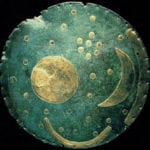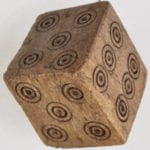 Creepy
Creepy  Creepy
Creepy  Technology
Technology 10 Scientific Breakthroughs of 2025 That’ll Change Everything
 Our World
Our World 10 Ways Icelandic Culture Makes Other Countries Look Boring
 Misconceptions
Misconceptions 10 Common Misconceptions About the Victorian Era
 Mysteries
Mysteries 10 Strange Unexplained Mysteries of 2025
 Miscellaneous
Miscellaneous 10 of History’s Most Bell-Ringing Finishing Moves
 History
History 10 Great Escapes That Ended Right Back in Captivity
 Weird Stuff
Weird Stuff 10 Fascinating Things You Might Not Know About Spiders
 Food
Food 10 Everyday Foods You Didn’t Know Were Invented by the U.S. Military
 History
History 10 Odd Things Colonial Americans Kept at Home
 Creepy
Creepy 10 More Representations of Death from Myth, Legend, and Folktale
 Technology
Technology 10 Scientific Breakthroughs of 2025 That’ll Change Everything
 Our World
Our World 10 Ways Icelandic Culture Makes Other Countries Look Boring
Who's Behind Listverse?

Jamie Frater
Head Editor
Jamie founded Listverse due to an insatiable desire to share fascinating, obscure, and bizarre facts. He has been a guest speaker on numerous national radio and television stations and is a five time published author.
More About Us Misconceptions
Misconceptions 10 Common Misconceptions About the Victorian Era
 Mysteries
Mysteries 10 Strange Unexplained Mysteries of 2025
 Miscellaneous
Miscellaneous 10 of History’s Most Bell-Ringing Finishing Moves
 History
History 10 Great Escapes That Ended Right Back in Captivity
 Weird Stuff
Weird Stuff 10 Fascinating Things You Might Not Know About Spiders
 Food
Food 10 Everyday Foods You Didn’t Know Were Invented by the U.S. Military
 History
History 10 Odd Things Colonial Americans Kept at Home
10 Fascinating Artifacts Of Mysterious Origin
A lot of the things that archaeologists dig up out of the ground are fairly straightforward—we know what people did with arrowheads and pots. But occasionally, we’ll turn up something that leaves experts scratching their chins and wondering “What’s that all about?”
10Middle Eastern Circles
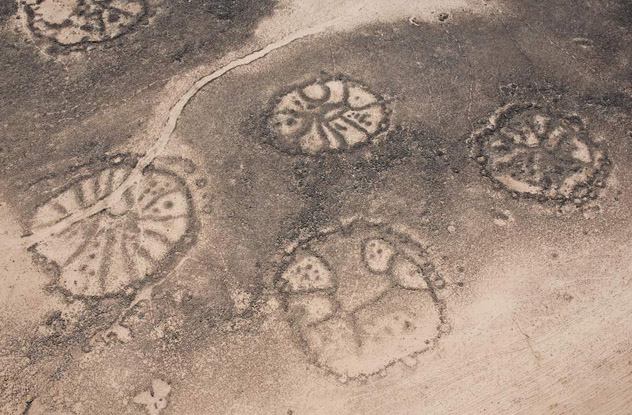
You may well be familiar with the Nazca Lines in Peru, ancient geoglyphs only properly visible from above. Their popularity with ancient alien proponents is second only to Egypt’s pyramids. Yet there’s an older, more mysterious, and even more common version in the Middle East that gets a lot less attention.
The “Wheels” are circular stone structures built in the desert from Syria to Saudi Arabia. Believed to be at least 2,000 years old, the structures weren’t rediscovered until the 1920s, after we’d invented planes. An archaeologist working on the structures said that you can make out a vague pattern from the ground, but you must ascend to at least 30 meters (100 ft) to view the structures clearly.
The purpose of the structures is unclear. Some are clustered together, and others stand alone. Some of the circles seem to have spokes aligned with astronomical phenomena, while others are apparently random. They could be the remains of buildings or cemeteries, though the most common belief is that they had some sort of religious significance to the people that made them.
9Fort Mountain
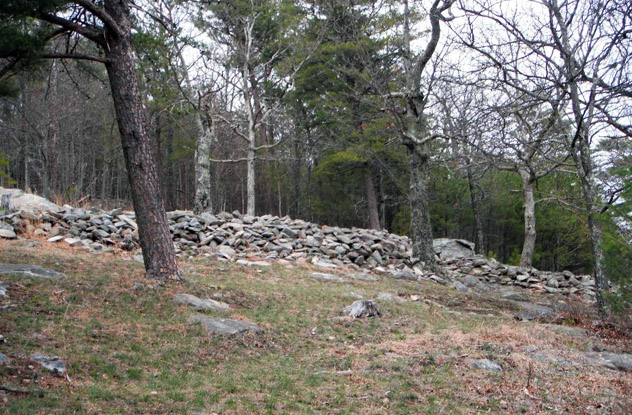
A trail marker tells hikers in Georgia they are approaching a “mysterious and prehistoric wall.” The wall’s builders are unknown. Its purpose is just as big a mystery.
The loose rock wall measures around 270 meters (885 ft) long and up to 2 meters (7 ft) tall in some sections. About 30 pits are scattered along its length, and one section contains the ruins of a gateway. It was built around 1,600 years ago, though the pits may have been dug much later by European treasure hunters.
The obvious theory behind the wall says it was used to defend the mountain from attack, but this seems unlikely. There’s no water source, the wall is left very low in some places, and it completely ignores any strategic slopes. Other theories suggest the wall had some use in sun worship or even marked the boundary of a haven for newlyweds to honeymoon.
The wall zigzags in a way that matches patterns found on some Native American pottery. Its shape may follow the movement of celestial bodies, and the north end of the wall points to where the Sun rises during the summer solstice. Cherokee legends about the wall suggest its builders were subterranean, tall, light-skinned, bearded, nocturnal, and “moon-eyed.” This is possibly a reference to Hitchiti tribes that used to live in the area, as they wore beards and dwelled in earth lodges that resembled caves. If they were tall and enjoyed astronomy, then the explanation fits.
8Derek Mahoney’s Glastonbury Cross

One of the many legends surrounding King Arthur is that monks from Glastonbury Abbey found his coffin in 1191. Alongside him was a lead cross, engraved with “HIC IACET SEPULTUS INCLITUS REX ARTHURIUS IN INSULA AVALONIA”—which translates to “Here lies entombed the renowned King Arthur in the island of Avalon.”
Many believe that, if it existed, the cross was a hoax by the monks to encourage pilgrims to visit. Even so, a hoax from the 12th century is historically very valuable. The last record of the cross was in the 17th century. That meant experts were very keen to investigate when a man turned up at the British Museum in December 1981 claiming to have found it.
Unfortunately, Derek Mahoney refused to hand the cross over after the museum staff first examined it. The museum called local authorities, who owned the land where Mahoney had supposedly found the item, and the council got a court order for the cross’s return. Mahoney still refused. In April 1982, a judge put Mahoney in prison for two years but said he’d be released immediately as soon as he revealed the cross’s location.
In January 1983, England’s Official Solicitor, tasked with looking out for people unable to represent themselves, went to court to argue for Mahoney’s release. Mahoney, oddly enough, argued that he should stay in prison and the Official Solicitor should mind his own business. The same scenario played out in the country’s second-highest court, which ruled that Mahoney should be released. Despite his continued protests, he was ejected from prison.
It later turned out Mahoney had previously made molds for lead toys and so had many of the skills needed to create such a cross. Even if he had faked it, he had done well enough to fool the experts who saw it—and well enough to convince authorities he should go to prison for it. Unfortunately, we may never know the truth, as the cross was never seen again.
7The Unicorn Tapestries
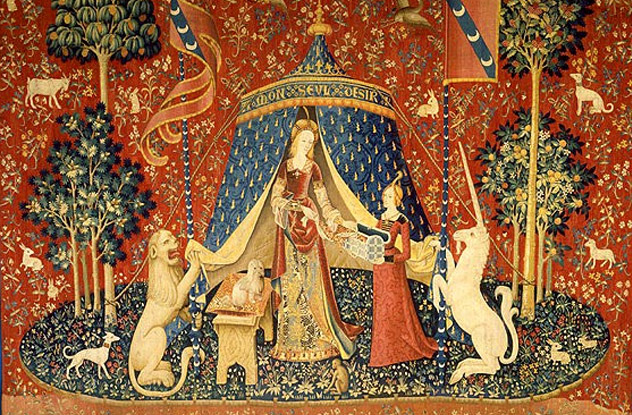
Six beautiful tapestries depicting the hunt of a unicorn are on permanent display at the Musee de Cluny in Paris. They’ve been called the “Mona Lisa of woven artworks,” but no one knows who created them. Despite their being made in the 15th or 16th century, no mention of the tapestries exists before 1814. No one took any notice of them until 1841, when the damp and nibbled items were rescued from their home in the Chateau de Boussac.
Some clues to their history are to be found in the monograms on each corner— “AE” and “AF”—yet no one knows to what they refer. Five of the six tapestries feature a slim, blonde lady, and we can only speculate on who she is. Many historians suggest it’s Mary Tudor, sister of Henry VIII, who was married to King Louis XII of France for the last six months of his life. Curators see secular allusions to marriage, love, and the desire for children that would back up that theory.
Others suggest the scenes reflect the five senses. In the first, the woman touches the unicorn, then she feeds a bird, smells flowers, plays music, and finally shows the unicorn his reflection. Christian scholars suggest the unicorn represents Christ being tamed by his mother the Virgin Mary. Or, if the tapestries’ film appearance in the Gryffindor common room is to be believed, they may represent an actual unicorn hunt.
6Florida Peruvian Skulls
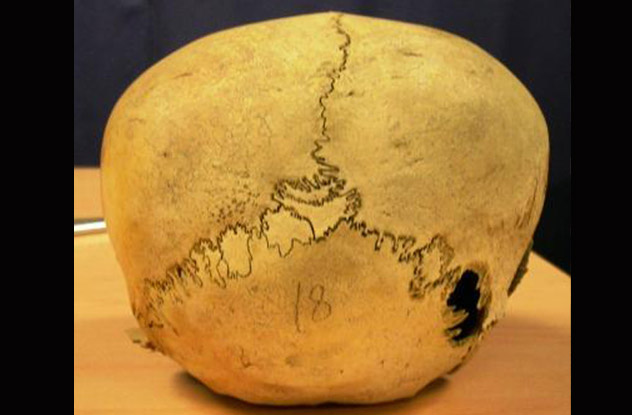
In January 2012, the skulls of a man and a boy were found during an excavation for a South Florida swimming pool. The smaller skull was of a 10-year-old and still had tissue on the bone. Police were called to investigate, but this wasn’t just some common crime. The flesh was mummified, and the skulls were at least 800 years old. Stranger still, the skulls had a unique structure known as an “Inca bone,” which occurs mainly in native Peruvians.
Other primitive artifacts, including woven cloth and slings, were found alongside the skulls. They may have been bought and left by tourists in the 1930s, before laws regulated the trade of such artifacts. Alternatively, migrant workers from Peru may have brought them as a link to their heritage. Either way, we’ll probably never know how they ended up under someone’s yard.
5Glozel Tablets
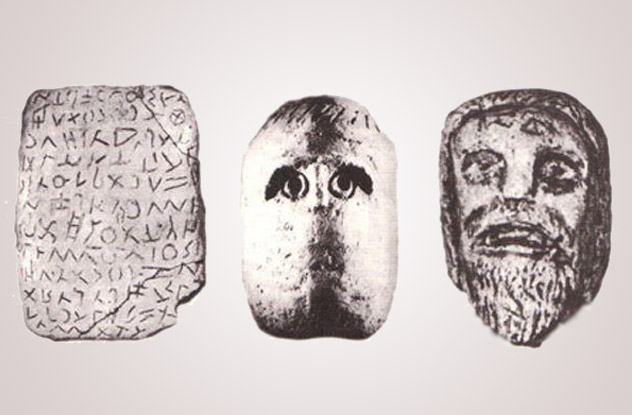
In 1924, a farmer named Emile Fradin found an underground chamber full of objects in one of his fields. There were strangely marked human bones, hermaphrodite idols, masks, and several tablets engraved with an unusual language. Fradin put out an open invitation for people to come and dig. They did so for years, and thousands of artifacts were uncovered.
Debate over the discoveries was so dramatic that the New York Times called it the “Glozellian war,” saying in 1927 that the whole of France was “divided into two violently opposed opinions” over whether the artifacts were genuine. Some archaeologists claimed that the items were from the Neolithic period and predated the Phoenician alphabet, from which the Greek, Hebrew, Latin, Arabic, and Cyrillic alphabets evolved. If that was true, the finds would mean the cradle of Western civilization was in France and not the Middle East.
The battle went to the courts. Fradin sued the head of the Louvre for defamation. Police raided the farmhouse and arrested the farmer for fraud after discovering freshly carved tablets—but believers claimed the fake tablets were plants. A report by international experts called them all fakes, but it just made everyone dig their heels in further. Fradin was never convicted of anything.
Modern tests say the bones range from as far back as 300 B.C. to as recently as the 1600s. Glass at the site is from Medieval France. The tablets themselves seem to match the earliest dates of the bones, making them over 2,000 years old. Their clay is chemically identical to the local clay, suggesting they originated there. Most now agree the text appears to be a form of old Celtic.
Yet there’s still a mystery as to why so many unusual and varied items ended up in a featureless field. No other site like it has been found anywhere in Europe. Fradin himself stuck to his story for 80 years, taking any secrets to his grave when he died in 2010.
4Mystery Stone
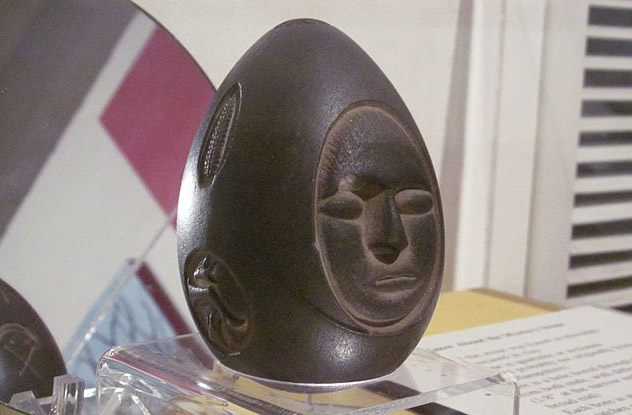
Construction workers digging near New Hampshire’s Lake Winnipesaukee uncovered a very unusual item in 1872. It was a black stone egg, about 10 centimeters (4 in) tall, carved with images. It was described as “remarkable” and a “wonder of the scientific world.” Nothing similar has ever been found anywhere in the United States to this day. It’s known as the “Mystery Stone.”
The carvings offered few clues as to the stone’s origins. The front of the egg shows a face. There’s an ear of corn on the side, a circle containing depictions of animal parts, a spiral, a crescent moon, and various patterns made of lines and dots. There are holes drilled into the top and bottom, which are too regular to have been created by pre–19th century technology, suggesting the stone was crafted not long before it was found.
No one recorded details about the stone’s discovery. We don’t know the exact site where it was found or how deep it lay. The type of rock it’s made from isn’t usually found in New Hampshire. After close to 150 years of investigation, we know no more than this: Someone created it for some reason at some point and it ended up buried.
3Golden Hats
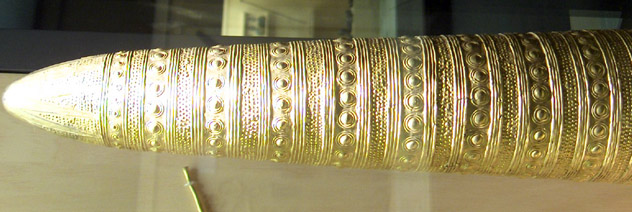
Some of the most unusual artifacts of Bronze Age Europe are four golden hats, or the cones. Ranging in height from 30 centimeters (12 in) to nearly a meter (40 in), the hats are made of almost 90 percent gold and are decorated with extremely elaborate concentric circles of symbols. The oldest known is the Berlin cone, which was created around 1300 B.C. and discovered in 1835. It’s covered in 1,739 sun and moon symbols, placing it at the limits of metalworking technology of its time.
Among the suggested uses for the cones have been hats for suits of armor, ceremonial vases, decorations for a place of worship, and even hats for “wizards”—more properly called “priest-astronomers.” A modern analysis of the decorations suggests the cones accurately portray solar and lunar cycles thought first observed by astronomer Meton of Athens in the fifth century B.C.—meaning proto-Celtic cultures were centuries ahead of their time.
2Egyptian Spider Art
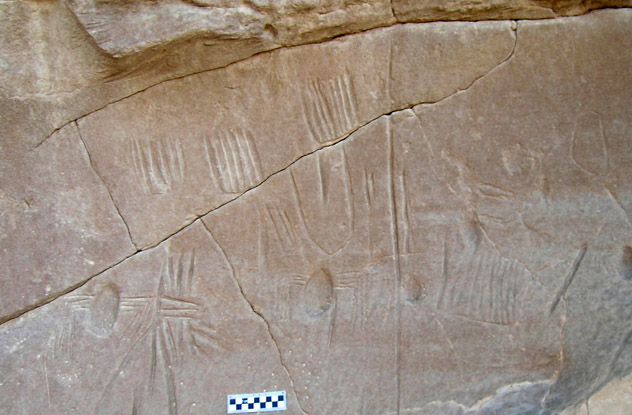
In 2013, archaeologists in Egypt discovered a stone panel engraved with what may be the earliest known depiction of spiders in the world. The panel is likely around 6,000 years old, making it older than the Ancient Egyptian civilization.
The suggestion that the drawings are spiders is “tentative” but reasonable. The carved ovals with four thin, bent “legs” sticking out of each side look very much like a stick spider picture. A star-like shape may be a web, and comb-like rows of lines could be a web funnel.
Dr. Heather Lynn, an author and proponent of “alternative archaeology,” suggests the carvings actually a represent the Sirius star system. Older star charts are known, and ancient people definitely liked to look up. There’s much more evidence for Egyptian astronomy than for an interest in spiders. There’s also the possibility that both are correct, and some poor souls from 4000 B.C. went through their lives believing the sky was full of arachnids.
1Aramu Muru
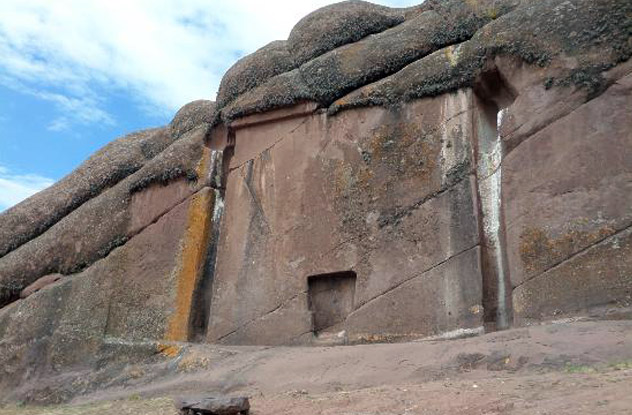
The Incan Doorway of Aramu Muru in Peru is a large square carved into a surface of rock. It’s 7 meters (23 ft) on each side, smoothed into a flat surface on an outcrop. In the center of the square at the bottom is an alcove a few feet wide and about as tall as a person. It looks like someone had started carving a building into the rock and just gave up.
The door has gained a cult following among believers in the paranormal, who say it’s a magical portal. Locals say it leads to the underworld and can be opened by magicians with special keys or enchantments. Some say it opens at midnight and there is a city on the other side. It’s even been suggested as a gateway to a distant part of the universe.
Could South American natives really have accomplished magical interstellar travel thousands of years ago? It would be nice if that’s what they were attempting. The alternative is that someone was forced to give up their awesome construction project, and that’s just a little bit sad.
Alan genuinely believes any of these items would’ve made a better Indiana Jones film than Crystal Skulls.
